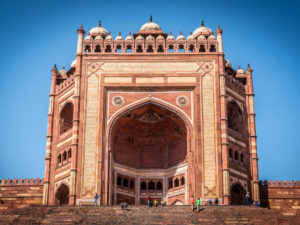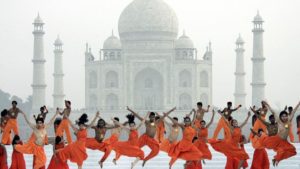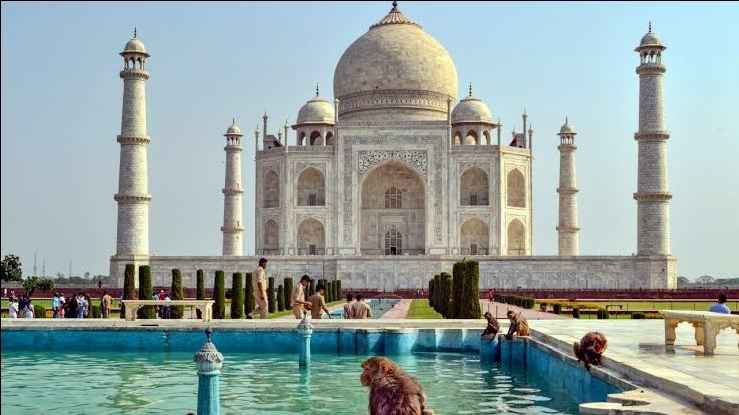Located on the banks of River Yamuna in Uttar Pradesh, Agra is a popular tourist destination as it is home to one of the 7 wonders of the world, the Taj Mahal. It is a sneak peek into the architectural history and legacy of the Mughal empire with two other UNESCO World Heritage Sites Agra Fort and Fatehpur Sikri. History, architecture, romance all together create the magic of Agra, and hence, makes for a must-visit for anyone living in or visiting India.
Agra is one of the most populous cities in Uttar Pradesh and 24th most populous city in India. With its long and rich history, it is no wonder that Agra forms part of the popular Golden Triangle Circuit for tourists along with Delhi and Jaipur. It is also a part of the Uttar Pradesh Heritage Arc including Varanasi and Lucknow. History fanatics and architecture buffs are sure to have a ball here with the sheer expanse of the Mughal art and culture on display.
Apart from its monuments, Agra has some exciting stuff for foodies. It is as famous for its Petha (a sweet made from pumpkin and flavored with rose water and saffron) as it is for the Taj Mahal. Agra is also well known for its marble artifacts, which are best bought in the Sadar Bazaar or Kinaari Bazaar area.
Agra is mostly visited on a one-day trip from New Delhi or other nearby cities in Uttar Pradesh but is totally worth it. Be prepared to be astounded, amazed, inspired and thrilled. However, be a little cautious about conmen in the guise of unofficial tour guides and fake handicrafts.
Places To Visit In Agra
Taj Mahal: One of the Seven Wonders of the World, Taj Mahal is located on the banks of River Yamuna in Agra. It was built by the Mughal Emperor Shah Jahan as a memorial for his third wife, Mumtaz Mahal. It also houses the tomb of Shah Jahan himself. Constructed entirely out of white marble in the 17th century, Taj Mahal is one of the most beautiful monuments in the world. Every year visitors numbering more than the entire population of Agra pass through the magnificent gates to catch a glimpse of this breathtaking monument!

Fatehpur Sikri: Located at a distance of 40km from Agra, Fatehpur Sikri is a town in the Agra district and a famous tourist attraction. A city predominantly made of red sandstone; Fatehpur Sikri was founded in 1571 century by Mughal Emperor Akbar. It is essentially a fortified city built by the king and had been the capital of his Empire for fifteen years. Now a UNESCO world heritage site, it is home to Jodha Bai’s Palace, Jama Mosque, Buland Darwaza, and Tomb of Salim Chisti among many other famous monuments. Derived from Arab and central Asian tent encampments, the Imperial Complex is a work of pavilions arranged in formal geometry on a piece of land.
Agra Fort: An architectural masterpiece, The Red Fort of Agra or Agra Fort was built by Emperor Akbar in 1573. It is located on the right bank of the River Yamuna and is made entirely of red sandstone. The historical fort was once the erstwhile residence of the Mughals until 1638. One of the UNESCO World Heritage Sites, it lies 2.5 kilometers from Taj Mahal.
Tomb of Itimad-ud-Daulah: Often referred to as the “Baby Taj Mahal”, the tomb of Itimad-ud-daulah is a Mughal mausoleum and often regarded as a copy of the Taj Mahal. This is the first tomb in India made entirely of marble. The tomb was commissioned by Nur Jahan, the wife of Jahangir, for her father Mir Gheyas Beg (later known as Itimad-ud-daulah), who was a minister in the court of Shah Jahan.
Mehtab Bagh: Mehtab Bagh is a charbagh garden complex and one of the last Mughal gardens in Agra. It is located just north to the Taj Mahal and overlooks the Agra Fort and Yamuna river on the opposite side. Perfectly aligned with the gardens of Taj Mahal, Mehtab Bagh provides a picture-perfect view of the Taj from the fountain at the front of the entrance gate. It is a popular sunset spot among the photography fanatics and nature enthusiasts.

Shopping In Agra: Agra is known for numerous varieties of unique and extinct crafts, which are nowhere to be seen these days. One of the most commonly bought collectables is a small marble replica of Taj Mahal. The shopping scene in Agra is buzzing with markets, department stores, retail outlets and local bazaars. Agra is home to many people like the artisans, jewelers, embroiders, carpet makers and weavers who come here to showcase their precious talent. Agra is one of the largest markets for embroidery and textiles. Most of the major shopping complexes are situated near the Taj Mahal, the most famous ones being Sadar Bazaar, Kinari Bazaar and Munro Road.
Tomb of Akbar: The final resting place of Mughal Emperor Akbar, Akbar’s Tomb is situated in Sikandra, the outskirts of Agra and spreads over an area of 119 acres. An important architectural masterpiece of the Mughal era, it was built between 1605 and 1618. Built entirely out of sandstone and white marble, Emperor Akbar himself oversaw the construction of this tomb until his death. Unlike the other tombs of famous Muslim kings around the world, the Tomb of Akbar faces towards the rising sun instead of Masjid of Mecca.
Jama Masjid: Jama Masjid at Agra also known as ‘Friday Mosque’ is a seventeenth-century structure and is one of the largest mosques built by the Mughals in India. Constructed under the reign of Shah Jahan in 1648, Jama Masjid is dedicated to his favorite daughter Jahan Ara Begum. This splendid monument is visible from the Agra Fort with the Agra Fort Railway station right between the two structures.
Chini ka Rauza: Chini ka Rauza is the tomb of Allama Afzal Khan Mullah, the Prime Minister of the Mughal Emperor Shah Jahan. Also known as China Tomb, it was built between 1628 and 1639 and has a marvelous fusion of the Indo-Persian style. It is the first monument of its kind to be decorated by glazed tile work, known as chini.
Jahangir Mahal: The residential palace of Jahangir Mahal, stands tall in the Agra Fort complex. Built by Akbar, in the 17th Century, this Red Sandstone marvel is a multistoried palace with a series of courtyards running from north to south, along the eastern fort wall. The palace is located north of Akbari Mahal, another important Mughal marvel that now breathes in its ruins and faces the river Jamuna. One of the most popular tourist places in Agra, the Jahangir Mahal served as a private residence to Akbar’s son and successor, Jahangir.

Taj Mahotsav: Taj Mahotsav is an annual ten-day festival that takes place in Agra. The festival showcases an outstanding variety of art and craft, dance and cuisines of artisans from different regions of India. Kicked off in 1992, this festival provides the platform to the artisans from various states to display their exquisite works of art at the same time also making them available to the tourists at the most reasonable prices. Apart from that, the festival is also a paradise for, food aficionados with a supply of a plethora of varieties of cuisines, children with a Fun Fair in place and the appreciators of folk culture.
Best time to visit Agra?
The best time to visit Agra is in the winter season between November to March when the weather is perfect for sightseeing. Another good time to visit Agra is between August and October to witness the Taj Mahal at its best. April-June is the summer season in Agra, which is scorching hot and not a good time to visit. July-September is the monsoon season in Agra when the weather can get humid at times.
How to Reach Agra
Most tourists visit Agra along with Delhi and/or Jaipur, and the road and train network is excellent from both of these places, as well as from other places in India. The Taj expressway that connects Agra to nearby destinations is one of the best roads in India. For people coming from long distance, taking a flight to Delhi and driving from there is recommended. www.holidify.com





